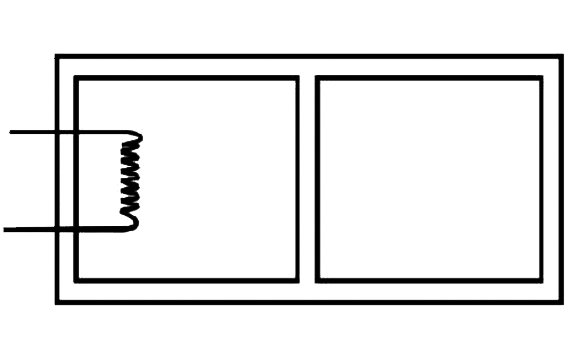A thermally insulated vessel contains an ideal gas of molecular mass M and ratio of specific heats γ. It is moving with speed v and it's suddenly brought to rest. Assuming no heat is lost to the surroundings, Its temperature increases by: Solution in Gujrati
(a)γMv22RK
(b)(γ−1)2RMv2K
(c)(γ−1)2(γ+1)RMv2K
(d)(γ−1)2γRMv2K
The correct Answer is:B
12Mv2=f2RΔTandγ=1+2f⇒ΔT=(γ−1)2RMv2
Topper's Solved these Questions
- BOOK - ALLEN CHAPTER - GEOMETRICAL OPTICSEXERCISE - EXERCISE - 05 (B)58videos
GEOMETRICAL OPTICS
- BOOK - ALLEN CHAPTER - GEOMETRICAL OPTICSEXERCISE - EXERCISE - 05 (B) (MCQ)9videos
GEOMETRICAL OPTICS
- BOOK - ALLEN CHAPTER - GEOMETRICAL OPTICSEXERCISE - EXERCISE - 04 (B)15videos
GEOMETRICAL OPTICS
- BOOK - ALLEN CHAPTER - CURRENT ELECTRICITYEXERCISE - EX.II66videos
CURRENT ELECTRICITY
- BOOK - ALLEN CHAPTER - GRAVITATIONEXERCISE - EXERCISE 49videos
GRAVITATION
Similar Questions
A vessel contains a mixture of one mole of oxygen and two moles of nitrogen at 300K. The ratio of the average rorational kinetic energy per O2 molecules to that per N2 molecules is
03:03View SolutionLet ¯v,vrms and vp respectively denote the mean speed, the root-mean - square speed, and the most probable speed of the molecules in an ideal monoatomic gas at absolute temperature T. The mass of a molecule is m:-
01:16View SolutionThe rectangular box shown in Fig has partition which can slide without friction along the length of the box. Initially each of the two chambers of the box has one mole of a mono-atomic ideal gas (λ=5/3) at a pressure P0, volume V0 and temperature T0. The chamber on the left is slowly heated by an electric heater. The walls of the box and the lead wires of the heater is negligible. The gas in the left chamber expands pushing the partition until the final pressure in both chambers becomes 243P0/32. Determine (i) the final temperature of the gas in each chamber and (ii) the work done by the gas in the right chamber.
 02:37View Solution
02:37View SolutionIn the Bohr's model of hy drogen atom, the electron moves around the nucleus in a circular orbit of radius 5×10−11m. Its time period is 1.5×10−16s. The current associated with the electron motion is:-
03:52View SolutionAssertion : The difference in the value of acceleration due to gravity at pole and equator is proportional to square of angular velocity of earth.
Reason : the value of acceleration due to gravity is minimum at the equator and maximum at the pole.05:39View SolutionA themallly insulated vessel contains an ideal gas of molecular mass M and ratio of specific heats γ. It is moving with speed v and it's suddenly brought to rest. Assuming no heat is lost to the surroundings, Its temperature increases by:
03:13View SolutionCertain amount of an ideal gas is contained in a closed vessel. The vessel is moving with a constant velcity v . The molecular mass of gas is M . The rise in temperature of the gas when the vessel is suddenly stopped is (gamma C_(P) // C_(V))
View SolutionA thermally insulated vessel containing a gas, whose molar mas is equal to M and specific heat capacity ratio gamma , moves with a velocity V . Find the temperature rise when the vessel is stopped suddenly.
View SolutionA thermally insulated vessel containing diatomic gas of molar mass M is moving with velocity v. the temperature of gas is T. if it is suddenly stopped, then
View Solutionएक ऊष्मारोधी बर्तन में आणविक द्रव्यमान M तथा विशिष्ट उष्माओं के अनुपात γ वाली एक आदर्श गैस भरी है। यह चालv् से गतिमान है तथा अचानक विराम अवस्था में लायी जाती है। यह मानकर की वातावरण में ऊष्मा की कोई हानि नहीं होती है, गैस के ताप में वृद्धि होगी :
View SolutionA thermally insulated vessel containing monatomic gas is moving with a speed of 30 m/s. If the vessel suddenly stops, the increase in gas temperature is (Molar mass of gas = 83 g/mol and R = 8.3J/K mol)
View SolutionA thermally insulated vessel contains an ideal gas of molecular mass M and ratio of specific heats gamma . It is moving with speed v and it is suddenly brought to rest. Assuming no heat is lost to the surroundings, its temperature increases by:
03:28View SolutionA thermally insulated vessel contains an ideal gas of molecular mass M and ratio of specific hears gamma . It is moving with speed v and is suddenly brought to rest. Assuming no heat is lost to the surroundings, its temperature increases by ,
02:09View SolutionA thermally insulated vessel contains an ideal gas of molecular mass M and ratio of specific heats gamma . It is moving with speed v and is suddenly brought to rest. Assuming no heat is lost to the surroundings, its temperature increases by:
07:40View SolutionA thermally insulated vessel contains an ideal gas of molecular mass M and ratio of specific heats γ. It is moving with speed v and is suddenly brought to rest. Assuming no heat is lost to the surroundings, its temperature increases by:
View SolutionA thermally insulated vessel contains an ideal gas of molecular mass M and ratio o specific heats γ. It is moving with speed v and is suddenly brought to rest. Assuming no heat is lost to surroundings, its temperature increases by
03:20View Solution

